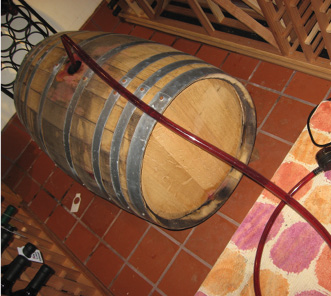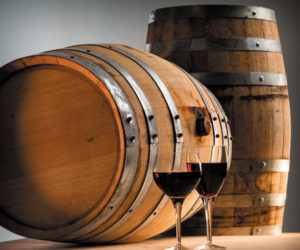Q
I am using three barrels this season (a 59-gallon/223-L and two 15-gallon/57-L) and 5 to 6 glass carboys ranging from 1 to 6 gallons (4 to 23 L). Two of the barrels seemed to not ever start malolactic fermentation (MLF). The other barrel and all of the carboys have completed MLF. I did a sulfite check with pipets on the two problem barrels and the sulfite reading was 50–60 ppm. This same wine in the carboys is reading 20–30 ppm or lower. The two problem barrels were stored wet with sulfur and citric acid per instructions. I rinsed the barrels after draining the solution and dried for 3–5 days, the day prior to adding wine we smoked the barrels with a sulfur stick and then pumped the wine into the barrel. So where did the extra sulfite come from, the smoke or the wood?
Matt Starr
Boulder, Colorado
A
The bad news in all of the above is that malolactic bacteria are extremely sensitive to sulfur dioxide. For that reason, it’s critical to not add any SO2 to wine, in any form, between primary and secondary (MLF) fermentation if you want to give your bacteria the best chance of survival. I believe the extra SO2 you’re measuring (even if it’s a rough analysis) came both from the wet storage solution and especially from burning a sulfur wick before filling. Even though you dried the barrels out for a few days before filling, wood is porous and so will often retain a little bit of the sulfur storage solution. Additionally, some of the SO2 gas created by the sulfur wick certainly will transfer into the wine as sulfur dioxide. While it’s probably safer to store your barrels with sulfur solution rather than with nothing, you may want to avoid burning sulfur wicks in a barrel before transferring in wine that you intend to go through MLF.
As for how to get your wine to go through MLF again, I’ll provide a list of tips. To have successful fermentations, the most important thing is to “think like a bacterium.” Just like us, yeast and bacterial cells like conditions to be nice and comfortable for them to do their best work. As a winemaker, your job is to provide your ML bacteria with an optimal environment so they can get down to business. To that end:
• Keep temperatures of your wine above 60 °F (16 °C) if you can. Too cold and they’ll slow down. Try an electric blanket on your barrels or an aquarium heater in the bung.
• Make sure the pH isn’t too low. ML bacteria don’t like high acid conditions. You’ll have best luck if your pH is above 3.20.
• Minimize SO2. Never add SO2 to wine between primary and MLF as ML bacteria are very sensitive to SO2. In your case, I would not have sulfured the barrel headspace with the sulfur wick.
• Pick your grapes early enough so the alcohol stays under 15%. This means not going much above 24.5–25 °Brix, depending on your alcohol conversion rates. ML bacteria have a harder time working if the alcohol is too high.
• Feed with MLF micronutrients. You can buy ML bacteria micronutrient mixes at home winemaking supply stores and online. ML bacteria are what we call finicky feeders and if conditions aren’t right and they lack some key mineral or vitamin they won’t operate at their best.
• Make sure you purchased your strain from a reliable source and that it’s fresh. I prefer to use the freeze-dried powdered cultures instead of dealing with messy liquid cultures that I have to grow. Make sure you’re buying a fresh packet every season and that it’s not through its expiration date. Store freeze-dried cultures according to instructions and definitely do not try to store an opened packet of ML bacteria from year to year. Freeze-dried, liquid, or on a slant (live culture growing on media), be sure it’s fresh and from a supplier with high turnover who has stored the “bugs” correctly.
• Consider re-inoculating. Try to change any of the above conditions that you can and then re-introduce ML bacteria to the wine. SO2 will dissipate with time so after a few weeks you might want to re-test your SO2. Hopefully it’s dropped a bit and you’ll have a better chance of getting your new culture on the right foot.
Q
I use One Step to clean and sanitize my bottles. I fill the sink, wash bottles, then rinse with tap water. I use bottle brushes to scrub and then let them soak in the solution. Am I cleaning and sanitizing correctly? I use bottled water for everything, except while rinsing. During washing (with One Step), and then rinsing the carboys and bottles, I use my city tap water for convenience. I rinse the One Step, because it seems to have a slippery feeling when I work with it. The package says I don’t have to rinse, but I do. After rinsing the One Step, am I leaving a coating of water in the carboy and bottles with chorine that could impact the wine?
Bob Kyle
Michigan
A
One Step is a proprietary cleaning (and somewhat sanitizing) solution that is a secret formula; even the Wine Wizard will never know exactly what it’s made out of. From what I can find out, though, it sounds very similar to products I’ve used in my wineries which often go by trade names like Peroxycarb. Essentially, these products are a basic (high pH) powder of sodium percarbonate and sodium carbonate that also releases hydrogen peroxide when water is added. The basic nature of the solution loosens scale and detritus (the cleaning action) and releases hydrogen peroxide, which is a strong oxidizer and disrupts microbial cellular function to such a degree it can repress or kill yeast and bacteria. The makers of One Step and similar products usually will give a recommended concentration and contact time in order to maximize their cell-slaying power. For One Step, it’s 1 tablespoon per gallon (4 L) of water.
One Step claims, by its very name, to be a “one and done” kind of cleaner and sanitizer. From what I can learn about it, it is somewhat pH adjusted with sodium citrate so that it may not be as necessary, in some applications, to rinse with water or acidulated water. I would leave that choice up to you depending on your situation, however. If you can feel a slippery film or residue on your equipment, that’s one of the classic signs of a basic (high pH) environment. Think soap or how a solution of soda ash feels. I would wager that if you’re still feeling a slick film, you may have residual product on your surface. Because of that, I would be hesitant to have it come in contact with wine immediately afterwards and would instead follow One Step with an acidulated, then clean, water rinse. For the acidulated rinse, use 2 tablespoons of citric acid to 1 gallon (4 L) of water.
However, if you’re washing equipment before you store it long term, or if it’s something that you’ll sanitize again before use anyway, then certainly use One Step and don’t bother with the acid rinse.
As for using tap water with all your winemaking, you might want to see if your local water supply has chlorine in it. If so, you are putting your wines at risk of contracting TCA (trichloroanisole) contamination. Why not save money on all the bottled water and simply buy a chlorine filter?
Myself, I don’t like to use “secret formulas” to make wine; I like to know exactly what it is that I’m using in my wines and in my winery environment. I like to clean with Peroxycarb, do an acidulated water rinse then rinse with clean water. For sanitizing, I’m lucky enough to work in larger wineries so I use ozonated water to blast my microbes. Cleaning and sanitizing go hand in hand. If you can clean thoroughly with a combination of a basic cleaner (of which you know the ingredients) and good old elbow grease, there’s less of a chance that you’ll have a high population of microbes to kill later on. Don’t neglect sanitation but recognize its limitations. No amount of sanitizing can make up for the lack of good cleanliness.
Q
The barrel we fermented our red wine in was previously cleaned with pool chlorine. We washed it out several times to no avail. The wine was contaminated with chlorine. The wine smells and tastes bad. We racked it once. Is there a remedy?
Angelo P.
Myrtle Beach, South Carolina
A
Oh dear. I fear that your wine has been contaminated not just with chlorine, but with the dreaded TCA, or tri-chloroanisole aroma defect. Also known as the “corked” aroma, TCA is the scourge of winemakers the world over. Commercial as well as home winemakers have to be wary of this common wine aroma defect. The TCA aroma is caused when a naturally-present mold spore (from corks, or just in the environment) come in contact with ambient chlorine molecules from, for example, use of chlorine-based products in the winery. If conditions are just right, the mold spores might metabolize (ingest) some of the chlorine-containing compounds and spit out trichloroanisole as part of their digestive process. The result is a swampy, cardboardy “wet basement” type aroma that’s perceptible in miniscule amounts. It’s so potent that most of us can smell TCA at even such low concentrations as parts per trillion.
The reason we call this the “corked” aroma is because natural wine corks are the usual vehicle for these mold spores. Be aware, however, that these mold spores can be introduced in the winery environment from cardboard boxes, wooden pallets, or even old newspapers sitting around the cellar. When these mold spores encounter a chlorine molecule, stinky TCA is a possible result.
This is one of the main reasons I never let any cleaning agent containing chlorine cross my threshold. It’s also why you should always filter the water you use for cleaning, rinsing, or making additions in winemaking. I would retire that chlorine-cleaned barrel post-haste — cut it in half and use it to make a couple of planters outside. Since it is contaminated with chlorine and most likely with TCA, it has no further use in winemaking.
What to do with your TCA-smelling wine? You could try a little “wino-hack” trick that seems a little weird but, if the chemistry is right, sometimes works. Try balling up a few fistfuls of plastic wrap like Saran Wrap, putting it into a pitcher (about a 2–4 quarts/L size would work) and then pouring the offending wine over it. Let the wine and plastic wrap soak for a few minutes, give a stir, then pour off a sample of the wine into a glass. If it smells better, it means that some (or hopefully most!) of the TCA has absorbed onto the polyethylene plastic. Treat the rest of your wine this way and hopefully the level of TCA in your wine will reduce to such an extent that it can be consumed.
A TCA aroma defect is best prevented rather than treated. Never let chlorine cleaning agents come into contact with anything in your winery, buy a charcoal filter to run in-line or at the end of any of your water hoses, and make sure your corks are fresh and from a reputable supplier. It takes a little vigilance to reduce the incidence of TCA contamination in your winery but in this case an ounce of prevention is worth a few parts per trillion of stinky TCA taint.
Amendment Found in the August-September 2017 Wine Wizard
Dear Wine Wiz Readers,
Last issue, as part of a larger question from a reader about TCA (trichloroanisole, the “corked” aroma defect) prevention and management, I told readers about a “hack” I’ve heard about over the years. One soaks the wine in question with a fist-sized ball of plastic wrap, which will bind to the TCA to lessen its impact in the wine. Critically missing, however, was the important detail that the plastic wrap in question needs to contain PVDC (polyvinylidene chloride). A helpful and very knowledgeable reader, Rex Johnston, emailed WineMaker to help us clarify and update this response.
Here’s an excerpt from my answer:
“What to do with your TCA-smelling wine? You could try a little “wino-hack” trick that seems a little weird but, if the chemistry is right, sometimes works. Try balling up a few fistfuls of plastic wrap like Saran Wrap, putting it into a pitcher (about a gallon or half-gallon size would work) and then pouring the offending wine over it. Let the wine and plastic wrap soak for a few minutes, give a stir, then pour off a sample of the wine into a glass. If it smells better, it means that some (or hopefully most!) of the TCA has absorbed onto the polyethylene plastic. Treat the rest of your wine this way and hopefully the level of TCA in your wine will reduce to such an extent that it can be consumed.
A TCA aroma defect is best prevented rather than treated. Never let any chlorine cleaning agents come into contact with anything in your winery, buy a charcoal filter from a hardware store to run in-line or at the end of any of your water hoses and make sure your corks are fresh and coming from a reputable supplier with high turnover. It takes a little vigilance to reduce the incidence of TCA contamination in your winery but in this case an ounce of prevention is worth a few parts per trillion of stinky TCA taint. “
Mr. Johnston wrote to say the following:
“Saran Wrap was invented by Dow Chemical where I once worked. The original Saran Wrap was polyvinylidene chloride (PVDC), which has since been sold to S. C. Johnson, who changed the formulation to a polyethylene product that is not polar. The original PVDC is very polar and acts like a magnet to TCA which is also polar thus binding it up. Handi-Wrap, the new formulation of Saran Wrap, and other polyethylene products are not polar and will not bind up the TCA. Strech-tite sold by Costco is PVDC and will remove the TCA.”
Bottom line? If you do want to try to treat your wine at home with this hack, which does seem to work, you need to make sure that the plastic wrap you are using contains PVDC. Costco, here we come!
Thanks for sharing your experience with us, Rex!







